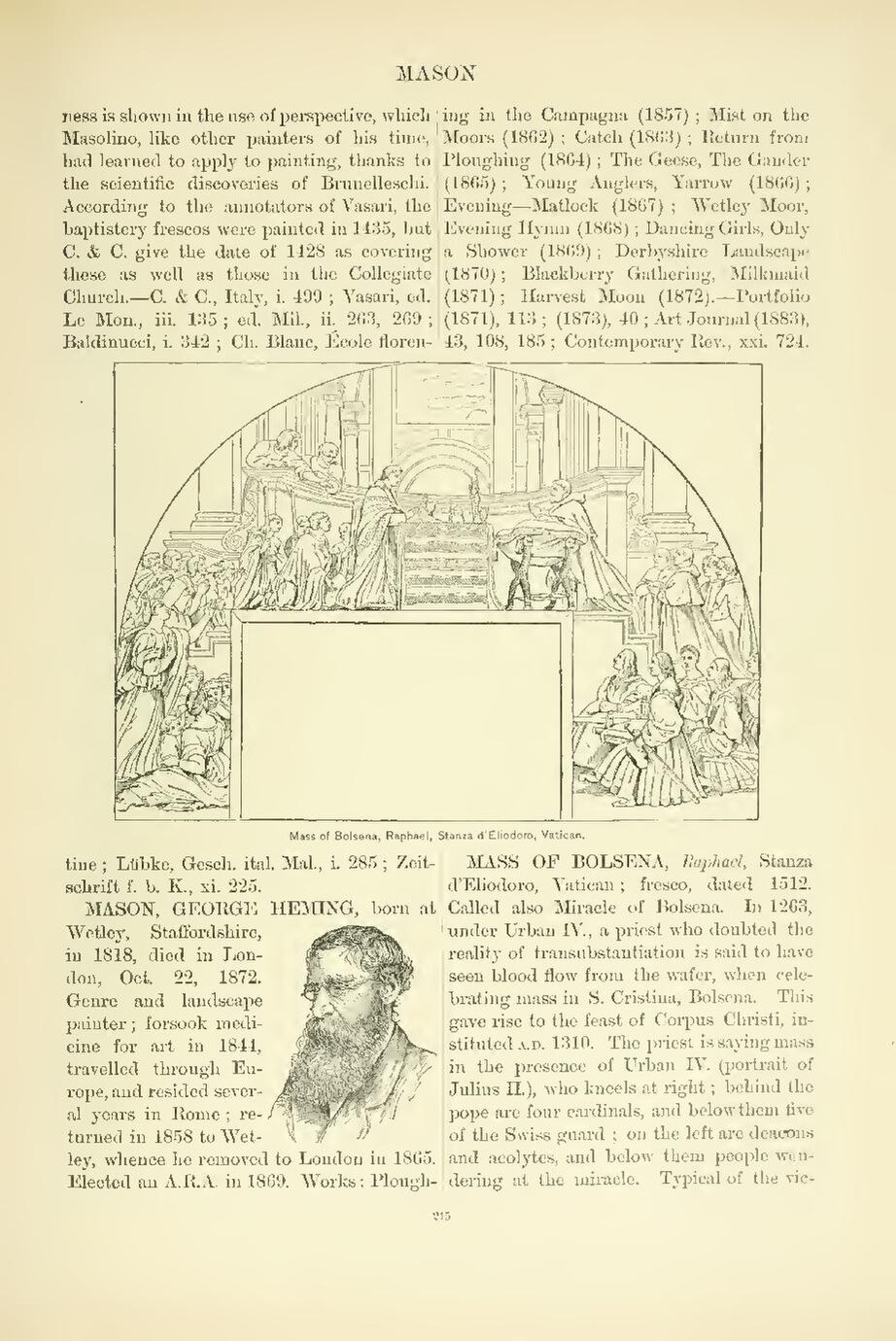- ness is shown in the use of perspective, which
Masolino, like other painters of his time, had learned to apply to painting, thanks to the scientific discoveries of Brunelleschi. According to the annotators of Vasari, the baptistery frescos were painted in 1435, but C. & C. give the date of 1428 as covering these as well as those in the Collegiate Church.—C. & C., Italy, i. 499; Vasari, ed. Le Mon., iii. 135; ed. Mil., ii. 263, 269; Baldinucci, i. 342; Ch. Blanc, École florentine; Lübke, Gesch. ital. Mal., i. 285; Zeitschrift f. b. K., xi. 225.
An image should appear at this position in the text. To use the entire page scan as a placeholder, edit this page and replace "{{missing image}}" with "{{raw image|Cyclopedia of painters and paintings (IA cyclopediaofpain03cham).pdf/237}}". Otherwise, if you are able to provide the image then please do so. For guidance, see Wikisource:Image guidelines and Help:Adding images. |
MASON, GEORGE HEMING, born at
Wetley, Staffordshire,
in 1818, died in London,
Oct. 22, 1872.
Genre and landscape
painter; forsook medicine
for art in 1844,
travelled through Europe,
and resided several
years in Rome; returned
in 1858 to Wetley,
whence he removed to London in 1865.
Elected an A.R.A. in 1869. Works: Ploughing
in the Campagna (1857); Mist on the
Moors (1862); Catch (1863); Return from
Ploughing (1864); The Geese, The Gander
(1865); Young Anglers, Yarrow (1866);
Evening—Matlock (1867); Wetley Moor,
Evening Hymn (1868); Dancing Girls, Only
a Shower (1869); Derbyshire Landscape
(1870); Blackberry Gathering, Milkmaid
(1871); Harvest Moon (1872).—Portfolio
(1871), 113; (1873), 40; Art Journal (1883),
43, 108, 185; Contemporary Rev., xxi. 724.
An image should appear at this position in the text. To use the entire page scan as a placeholder, edit this page and replace "{{missing image}}" with "{{raw image|Cyclopedia of painters and paintings (IA cyclopediaofpain03cham).pdf/237}}". Otherwise, if you are able to provide the image then please do so. For guidance, see Wikisource:Image guidelines and Help:Adding images. |
Mass of Bolsena, Raphael, Stanza d'Eliodoro, Vatican.
MASS OF BOLSENA, Raphael, Stanza d'Eliodoro, Vatican; fresco, dated 1512. Called also Miracle of Bolsena. In 1263, under Urban IV., a priest who doubted the reality of transubstantiation is said to have seen blood flow from the wafer, when celebrating mass in S. Cristina, Bolsena. This gave rise to the feast of Corpus Christi, instituted a.d. 1310. The priest is saying mass in the presence of Urban IV. (portrait of Julius II.), who kneels at right; behind the pope are four cardinals, and below them five of the Swiss guard; on the left are deacons and acolytes, and below them people wondering at the miracle. Typical of the vic-
